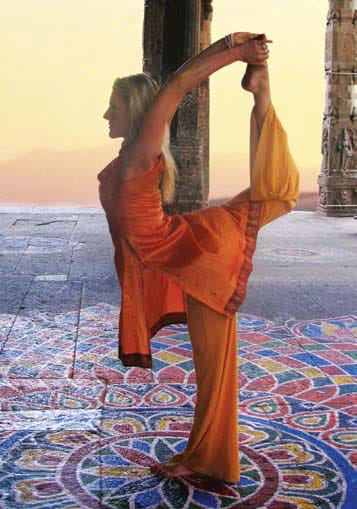A few years ago, a friend and I were tooling around the Berkshires’ rural roads, killing time while waiting for our yoga workshop at Kripalu to start. Suddenly my friend said, “Did you just see the goddess in the woods?” I craned my neck out the car window, but only managed to catch a glimpse of blond hair. Better was the workshop itself. Yes, the goddess my friend saw was Shiva Rea, one of America’s most celebrated yoga teachers. And, indeed, she did lead us through poses with something of a divine, yet thoroughly grounded, grace.
I reconnected with Rea while she was at her California home, located near her favorite surf break. She talked with me about what she sees as the power of self-less service and about the true and transformative nature of yoga.
Andrea Miller: Yoga literally means “to yoke.” What is yoked, or united?
Shiva Rea: In the yogic tradition, the highest level we can attain is communion with the ground of this consciousness, such that there is no longer anything to yoke. Different schools of yoga describe what is separating our experience of this natural state of consciousness in different ways.
In the West, when people say yoga, they think asanas or poses. But by no means does yoga mean asanas. For me, yoga is a state of unified consciousness that all beings experience naturally. So, the system of yoga is the vast collective wisdom—the methods, teachings, and realizations—of all sages, yoginis, poets, and householder teachers. This system is there for anybody who wants to cultivate the natural state of yoga as the base from which they experience life.
Then how do physical postures help us on this path?
Asanas are extraordinary mudras, ritualistic gestures that are understood in Buddhist practice to be concentrated forms reflecting different aspects of consciousness. So asanas, like mudras, balance or enhance our state of consciousness. When we bring our hands to our heart, it has an effect on our being—mentally, emotionally, physically. If we are open to asanas at that level, they will have that integrated effect. But if we think that we’re just doing a physical practice, then that may be all we experience.
What is a common obstacle on the yogic path?
Even if we don’t want to admit it, when we first come to yoga, we’re goal-orientated. But what use are strong abdominals or a very flexible spine? With them, you can still be a mean, agitated, and confused person. Unless your inner consciousness goes through the fullness of transformation, your life doesn’t change.
How has your yoga practice changed over time?
I’ve come to really yoke all of my senses and tune them, back—as close as I can—to their natural, unified flow of consciousness. Now yoga is less a thing that I’m doing, and more of a process I’m engaging in.
Ultimately, yoga helps us to dive deeper into what is truly important. Yet in many yoga classes, there’s a lot of competition in the air—a lot of striving to strike the pose perfectly or to have the best yoga pants. What would you recommend to remedy that?
First of all, I think it’s important to find the class—the community—where you feel that the person next to you is in a similar heart space. But it’s also important to keep in mind that if an earthquake were shaking the studio, no one would care that their leg was higher than someone else’s. I think that we just don’t have enough contact with life and death issues. That’s one reason why I travel. I did development work in Africa for two and a half years and I‘ve been to India nine times. When you get out to the village level, when you get out with people who have almost nothing, it helps you to cut through and get to what’s really important.
You do what’s called seva or self-less service?
Yes. I would like to do more hands-on seva like I did in the past, but most of my seva now is mobilizing consciousness and people. I’m connected with Trees for the Future, an organization which plants trees in the most degraded lands on the planet. My goal is to facilitate the sponsorship of two hundred villages, primarily in south India, and to plant over 1,000,008 trees.
Why is re-forestation a particularly important issue to you?
I think everybody has to find their way. It’s easy to be overwhelmed by the entire Earth’s problems. But they’re all interconnected—poverty being connected to energy resources, and energy resources being connected to how the land and the water are used. I’ve decided to focus on tree planting because I think it’s one of the most important ways we have to address global warming—an issue that transcends all borders. There will be even greater poverty if it’s not addressed.
But you’re also involved with other types of activism.
Yes, last year I started the Global Mala Project, which uses collective practice to unite yoga studios, practitioners, and schools, across the borders of their mats and their individual studios. This year, on September 21st and 22nd, each of the approximately fifty participating centers did a practice of 108 Sun Salutations, or 108 minutes of meditation, or some other practice in accord with their particular tradition. Each of these Global Mala events was dedicated to practice, or to practice and seva. The centers raised funds for the organization of their choice, with the awareness that—no matter if it’s $108 or $1008—it’s is not a drop in the bucket when we join together to address the most urgent issues of our times.
Would you say it’s important that all people on a spiritual path have a seva component to their practice?
If we feel a huge pressure to be heroes and saints, then we may miss some deeper work. It’s really important to acknowledge that there are rhythms to seva. Sometimes the most important service we can perform has to do with our own internal universe, that is, the seva of giving ourselves a deep healing or reorganizing our lives. This seva benefits ourselves, but it also benefits others because it allows us to have an even greater positive effect on the world. At the same time, however, I think that we all have to get engaged now because everybody on this planet has a duty to move toward a sustainable lifestyle. Whatever way we can—with balance—let’s do that. Let’s begin.

